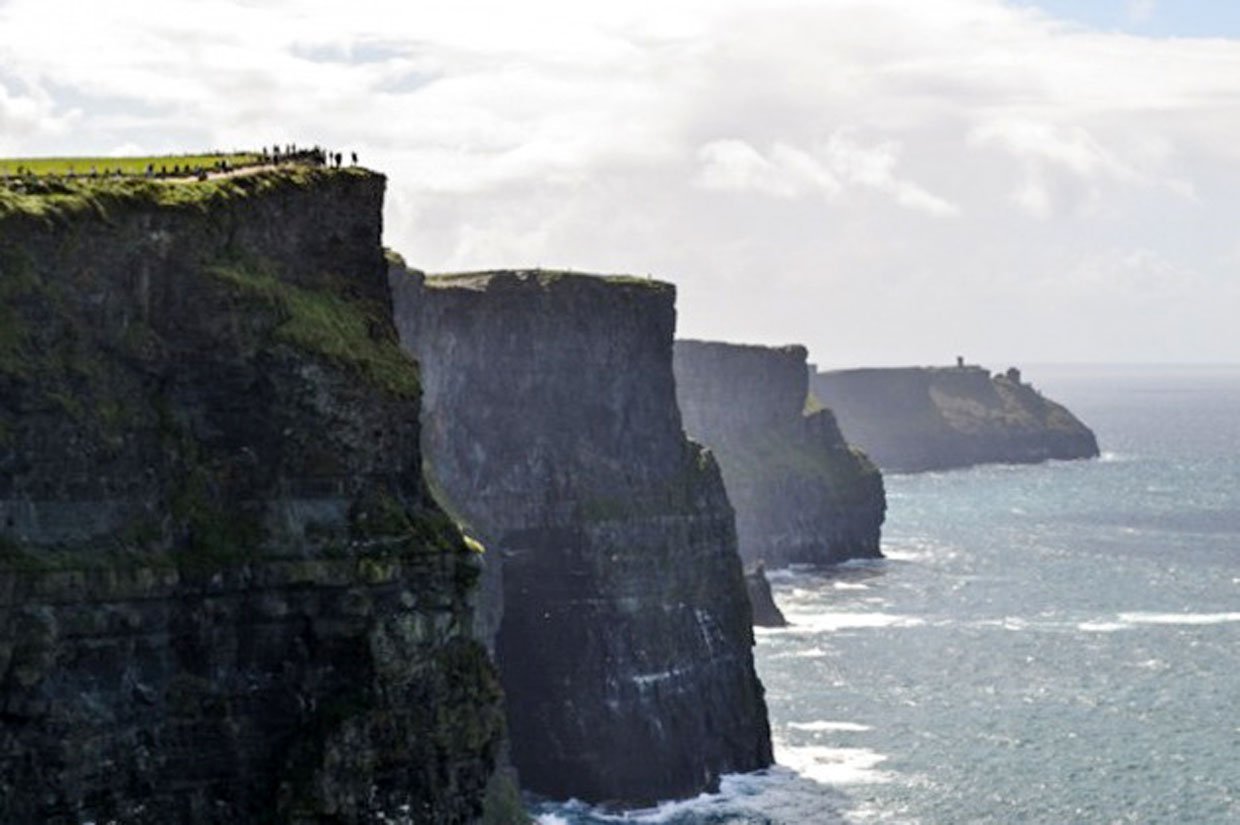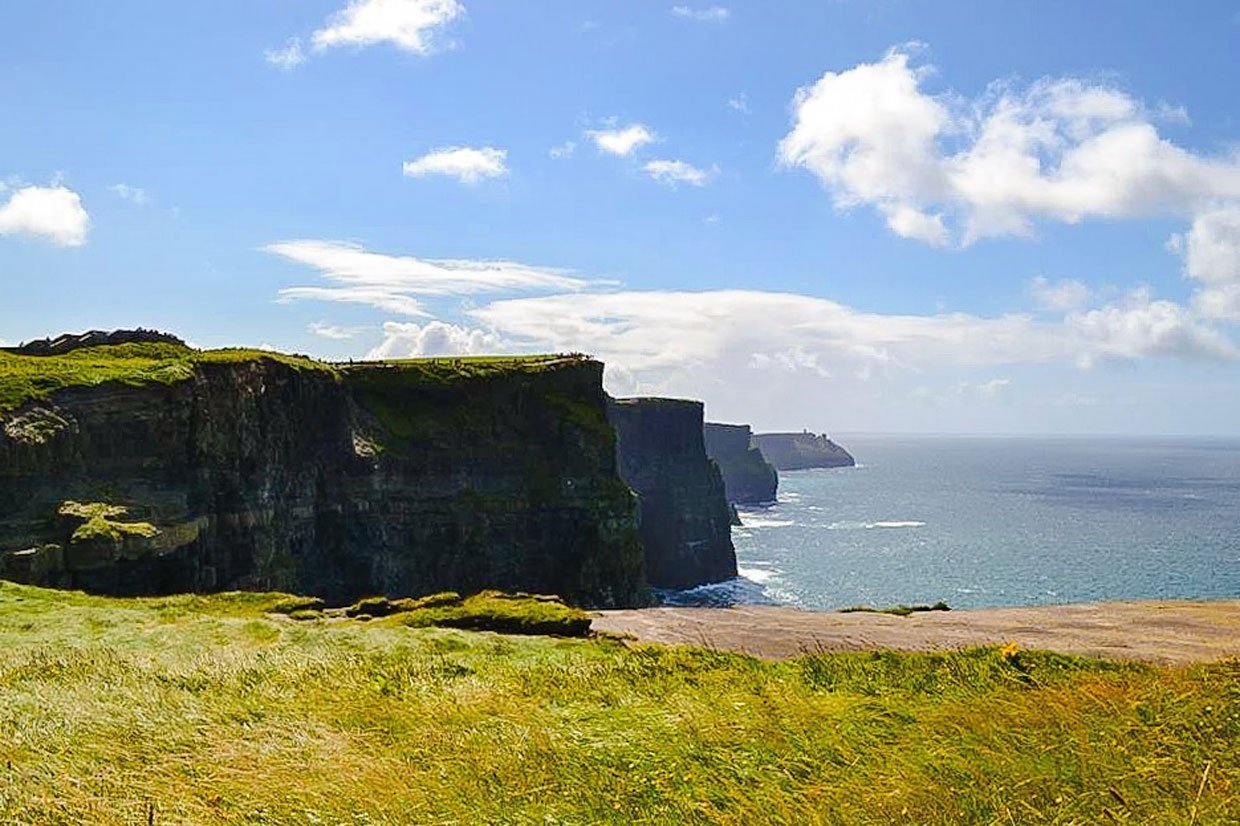It was a magical and very windy moment looking along the edge of the Cliffs of Moher. The plush green landscape curves along the edge where the waves of the Atlantic Ocean crash into the surface below creating one of nature’s most inspiring visions of landscape architecture.
I stopped along the edge witnessing the way nature curated the aesthetically pleasing surroundings while it beckoned me to become part of its story. A timeless story located at the southwestern edge of the Burren region in County Clare, Ireland.

The Cliffs of Moher rise 120 metres (390ft) above the Atlantic Ocean at Hag’s Head and reach their maximum height of 214 metres (702ft) just north of O’Brien’s Tower.
O’Brien’s Tower was built in 1935 by Sir Cornelius O’Brien. The round stone tower is near midpoint of the cliffs.

Geology
The base area below the cliffs are endowed with Namurian shale and sandstone. The Namurian period is a stage in the regional stratigraphy of northwest Europe with an age between roughly 326 and 313 Ma (million years ago).
The Millstone Grit Group in the lithostratigraphy of northern England and parts of Wales is also of Namurian age, during the Carboniferous Period.

The cliffs are made up of individual horizontal layers of rock or strata. These layers are clearly defined bands of rock of different thickness and composition.
The lighter layers are made up of sandstone. The darker layers are mostly made up of siltstone and shale which has a softer consistency than the sandstone that is slightly more resistant to erosion.

Even the sandstone layers of the cliffs can not totally hold up to the eventual erosion and will fall into the sea, this is why staying clear of the cliff edge is very important for safety.
It is known that some of the shale layers contain marine fossils such as ammonoids and crinoids. It is also known that the sea was eventually filled in to become land because there have been finds of fossil roots preserved within fossil soils in these rocks further along the coast.
Along the beach of the cliffs are lines that tell over a 300-million-year-old story. It is also where many species of birds call home. If I were a bird, I would definitely live here!
Bird species
The cliffs can boast one of the major colonies of cliff nesting seabirds in Ireland – offering you a viewing of over 20 different species. The area was designated a Special Protection Area (SPA) for Birds under the EU Birds Directive, with internationally important numbers of guillemot and razorbill and also has significant numbers of puffin, kittiwake and fulmar.
Puffin
Populations are dwindling throughout Europe, the numbers at the Cliffs are increasing in comparison. The Cliffs of Moher puffin is a member of the Auk family which winters at sea and returns to shore for the nesting season from late May to mid-July.
The best time of the year to view the Puffin Colonies along the length of the Cliffs is between May and June.
Guillemot
These are one of the most numerous birds in the great ‘seabird cities, ‘which only comes to land to nest and spends the rest of its life at sea. A dark brown and white bird that eats fish and crustaceans.
Fulmar
This species is related to the Albatross and can be seen all year round at the Cliffs where populations have thrived. It’s best to watch out for them in stiff-winged flight riding the thermals and updrafts over the Cliffs.
Razorbill
This is also member of the Auk family, with quite a distinctive heavy bill that is used to collect sand eels. Both the guillemot and razorbill can be seen nesting on the lower sections of the Great Stack. So remember to bring along your binoculars.

Filming Location
It is easy to see why the cliffs are one of the most visited tourists’ sites in Ireland. The Cliffs of Moher’s notable history in cinema shares the spotlight with several films including The Princess Bride (1987), Harry Potter and the Half Blood Prince (2009), and Leap Year (2010).
The cliffs have also appeared in several music videos.
Culture and history
Busking pitches are set aside at the Cliffs, a wonder experience in this beautiful location for a visitor and one that is specifically for local buskers wishing to bring their talent to the Cliffs. 12 annual busking licenses are available every year – given to buskers who meet the scheme criteria. Buskers who perform on a regular basis during the year can have their licenses renewed annually.

In 1808 a signalling tower was built at Hag’s Head by the British Army during the Napoleonic Wars (1803–1815) as a look out post. This replaced the earlier promontory fort, known as Mothar or Moher, which gave the Cliffs their name was demolished to provide material for this new signalling tower.
O’Brien’s Tower was later built as an observation tower for the hundreds of Victorian tourists visiting the area by a local man Sir Cornelius O’Brien; a descendent of the Kings of Thomond from Bunratty Castle and The High King of Ireland Brian Borou, in 1835.

It was a mild weather day on the visit to the cliffs and the wind was still quite fierce, nearly knocking me over at times. I can’t imagine what a stormy day must be like. If my footsteps ever lead me to the cliffs again, I will be staying long enough to witness a sunset.
There is no way to capture the experience of standing on the edge of the cliffs it is truly a moment I will not forget.








